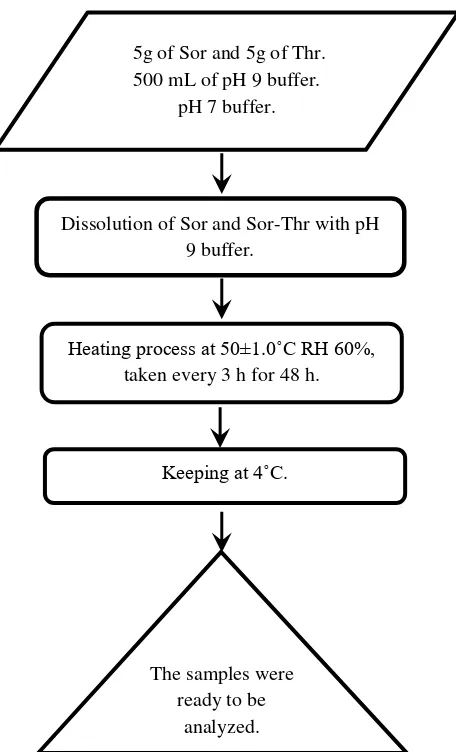13
CHAPTER III
MATERIAL AND METHODS
3.1. Material
Rare sugars of D-sorbose were obtained from Kagawa Rare Sugar Research Center, Japan. Threonine (Thr) (with the purity index 99%) was
obtained from Cheil Jedang Indonesia, Co. Ltd. ABTS or 2,2’
-azino-bis(3-ethylbenzthiazoline-6-sulfonic acid) was obtained from AppliChem, Germany (Lot No.2X001714). While, the instrument needed were digital balance, beaker
glass, micropipette, microtubes, dry oven, vortex, refrigerator, pH meter, spectrophotometer and digital colorimeter.
3.2. Methods
3.2.1. Preparation of MRPs Model
The preparation method of MRPs model has been adopted from Yu et al.
(2012) with minor modifications. The D-sorbose as a control, 1:1 D-sorbose-Threonine (Sor-Thr) was dissolved in 500 mL of 10 mM carbonate buffer (pH 9) solution. Then, two hundred microliter was transferred to 1.5 mL microtube prior
to application for heat treatment. The sample was subjected to 48 h heating
process at 50±1.0˚C RH 60% using the controlled dry oven. Measurements were
performed every three hour on hour 0 up to 48. After heating treatment, the dried
sample were cooled immediately in the air for 1 min, and then kept at 4˚C. The
samples to be measured dissolved up to 200 µlof 10 mM phosphate buffer (pH 7).
14
Figure 3. The flow diagram of Maillard reaction products
3.2.2. Browning Intensity
The browning intensity of the MRPs was measured according to the method of Ajandouz et al. (2001). The MRPs of Sor and Sor-Thr after heating
were dissolved up to 200 µl of phosphate buffer in microtube. Browning intensity of sample was measured by Spectrophotometer (UV-1280; Shimadzu, Kyoto,
Japan) at absorbance 420 nm.
3.2.3 Color Development
The MRPs samples of Sor and Sor-Thr after heating were dissolved up to 5g of Sor and 5g of Thr.
500 mL of pH 9 buffer. pH 7 buffer.
Dissolution of Sor and Sor-Thr with pH 9 buffer.
Heating process at 50±1.0˚C RH 60%, taken every 3 h for 48 h.
Keeping at 4˚C.
The samples were ready to be
15
to 200 µl of phosphat buffer in microtube. The color development or browning index of samples were determined by digital colorimeter TES-135 to obtain the
L* a* b* values. The instrument was calibrated with a standard white before measurement, then the browning index was calculated using the equation (2)
(Alvarenga et al., 2014).
(1)
(2)
Here L, a, and b are the values from digital colorimeter, x is the value obtained from equation (1), BI is the browning index or the final value. BI was obtained from equation (2).
3.2.4. Spectroscopic Measurements
The MRPs samples of Sor and Sor-Thr after heating were dissolved up to
to 200 µl of phosphate buffer in microtube. To analyze the spectral formation of MRPs, samples were measured by spectrophotometer at wavelength 190 – 750 nm. This spectroscopic measurements method has been adopted from Jing and
Kitts (2004).
3.2.5.. ABTS Radical Scavenging Activity
The ABTS radical scavenging activity of MRPs method has been adopted from Hwang et al. (2011) with some modification. 7 mM of ABTS reagent was diluted in 10 ml phosphate buffer pH 7.4. 5 ml of these ABTS solution was added
16
nm. Then, 1 : 9 of MRPs samples mixed with 90% ethanol, and ABTS stock solution were loaded in spectrophotometer. The percentage inhibition of MRPs
scavenging activity from Hwang et al. (2011) was calculated in equation (3).
(3)
Here A0 is the absorbance with blank and A1 is the absorbance with the sample.
3.2.6. Correlation between Browning Intensity and Scavenging Activity
The browning intensity and the scavenging activity were analyzed for R2 value. Values of R2 should be in a range 0 to 1 and it is close to 1, the positive correlation between browning intensity and scavenging activity should be
occurred. This correlation analysis method has been adopted from Alvarenga et al. (2014).
3.3. Data Analysis
The results were reported in figures and the figures were generated from appendix. The scavenging activity and physical phenomena of MRPs were
analyzed using descriptive analysis, and then the significance of correlation between browning intensity and scavenging activity was analyzed using Graphpad
Prism version 6.0. This study was adopted from Nilsson et al. (2004) and Aon and Colaneri (2001), who has stated that the significant correlation should be if P
